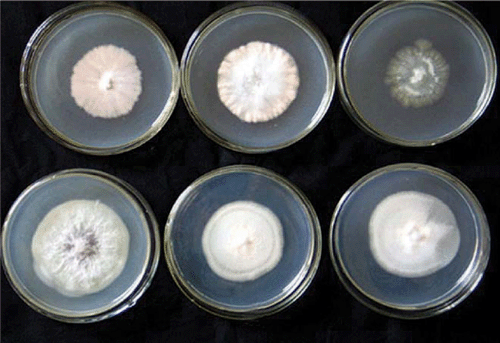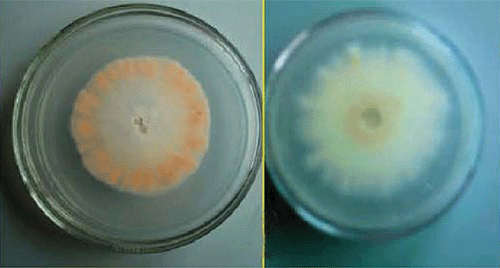Race 4 identification of Fusarium oxysporum f. sp. cubense from Cavendish cultivars in Hainan province, China
Y. X. Qi A B D , X. Zhang A , J. J. Pu A , Y. X. Xie A D , H. Q. Zhang A and S. L. Huang B CA Hainan Key Laboratory of Monitoring and Management of Pest of Tropical Agriculture, Environment and Plant Protection Institute, Chinese Academy of Tropical Agricultural Sciences, Danzhou, Hainan 571737, P.R. China.
B College of Life Science and Technology, Guangxi University, Nanning, Guangxi 530004, P.R. China.
C Nanyang Normal University, Nanyang, Henan 473061, P.R. China.
D Corresponding author: qiyanxiang@126.com; yixian81@126.com
Australasian Plant Disease Notes 3(1) 46-47 https://doi.org/10.1071/DN08018
Submitted: 5 January 2008 Accepted: 4 April 2008 Published: 11 April 2008
Abstract
Fusarium oxysporum f. sp. cubense from Hainan province of South China was identified by colony morphology on modified Komada medium (K2 medium). Forty isolates of F. oxysporum f. sp. cubense obtained from Cavendish cultivars sampled at random from 20 banana farms of Hainan province, China, formed laciniated colonies on modified K2 medium. None of the isolates of F. oxysporum f. sp. cubense sampled from 10 Gros Michel cultivars in five other banana farms in Hainan with the same method and six other species of Fusarium conserved in our laboratory formed laciniated colonies on the same medium. The results showed that it is a simple, fast and reliable method for identifying F. oxysporum f. sp. cubense Race 4.
Panama disease in banana, caused by Fusarium oxysporum f. sp. cubense, is one of the diseases that has caused the greatest damage to banana crops worldwide throughout the 20th century (Stover 1972). The highly susceptible cultivar, Gros Michel, used by growers until 1960, was replaced by clones of the Cavendish Subgroup. Although Cavendish cultivars are resistant to Race 1 and Race 2 of the pathogen, Race 4 damages these cultivars in subtropical banana-growing regions (Su et al. 1977). During surveys conducted in 2005 and 2006, a high incidence of Banana fusarium wilt on Cavendish cultivars was observed in Hainan province of South China. A rapid pathogenicity test using small seeding Gros Michel had previously been developed (Stover 1959), which was useful for rapid identification of F. oxysporum f. sp. cubense, but not for races of this fungus. We used colony morphology on modified K2 medium (Sun et al. 1978) to identify Race 4 of F. oxysporum f. sp. cubense in Hainan, China.
Forty isolates of F. oxysporum f. sp. cubense obtained from Cavendish cultivars sampled at random from 20 banana farms of Hainan province, China, and 10 isolates obtained from Gros Michel cultivars sampled from five other banana farms in Hainan with the same method, and six other species of Fusarium conserved in our laboratory, were tested on modified K2 medium.
The modified K2 medium consists of a basal medium and 100 mL of solution. The basal medium contains the following compounds in 900 mL of distilled water: K2HPO4, 1 g; KCl, 0.5 g; MgSO4.7H2O, 0.5 g; FeNaEDTA, 0.01 g; L-asparagine 2 g; galactose 10 g, and 16 g of agar. After autoclaving, the basal medium was mixed with 100 mL of solution containing the following agents: PCNB (pentachloronitrobenzene, 75% WP), 0.9 g; oxgall, 0.5 g; Na2B4O7 0.10H2O 0.5 g; streptomycin sulfate 0.3 g. The medium was adjusted to pH 3.8 ± 0.2 with 10% phosphoric acid. Six plates per treatment were used and colonies were observed after 15-day incubation at 28°C under fluorescent light. The experiment was repeated three times.
All 40 isolates of F. oxysporum f. sp. cubense obtained from Cavendish cultivars formed laciniated colonies on modified K2 medium that were distinct from those of isolates from 10 Gros Michel cultivars and six other Fusarium spp. (Fig. 1). The number of rays produced per colony ranged from 20 to 50 and the colonies appeared yellowish when observed from the bottom (Fig. 2). None of the isolates from Gros Michel cultivars and from six other Fusarium spp. formed laciniated radial colonies on the same medium. All the isolates of F. oxysporum f. sp. cubense from Cavendish cultivars, and 10 isolates from Gros Michel cultivars and six other Fusarium spp. did not produce laciniated colonies on potato-dextrose agar.

|

|
The Cavendish cultivars are susceptible only to race 4 (Su et al. 1977). According to the colony morphology on modified K2 medium (Sun et al. 1978), 40 isolates of F. oxysporum f. sp. cubense obtained from Cavendish cultivars from 20 banana farms of Hainan province, China, were race 4. These results further support the reliability of the method for identification of F. oxysporum f. sp. cubense race 4, at least for the isolates from Hainan. This may reflect the short history of the fungus in Hainan. It is likely that the fungus originated from a single introduction from Taiwan. However, it is possible that a clone of race 4 without laciniated colonies may be found in the future.
Acknowledgements
This work was reported by the grants 2003-Z32(B) from 948 project of the Ministry of Agriculture, 05303 from Hainan Provincial, Rky0302, Rky0516 and Rky0612 from Chinese Academy of Tropical Agricultural Sciences, the People’s Republic of China, respectively.
Stover RH
(1959) A rapid and simple pathogenicity test for detection virulent clones of Fusarium oxysporum f. sp. cubense using seedings of Musa balbisiana. Nature 184, 1591–1592.
| Crossref | GoogleScholarGoogle Scholar |

Sun EJ,
Su HJ, Ko WH
(1978) Identification of Fusarium oxysporum f. sp. cubense race 4 from soil or host tissue by cultural characters. Phytopathology 68, 1672–1673.



